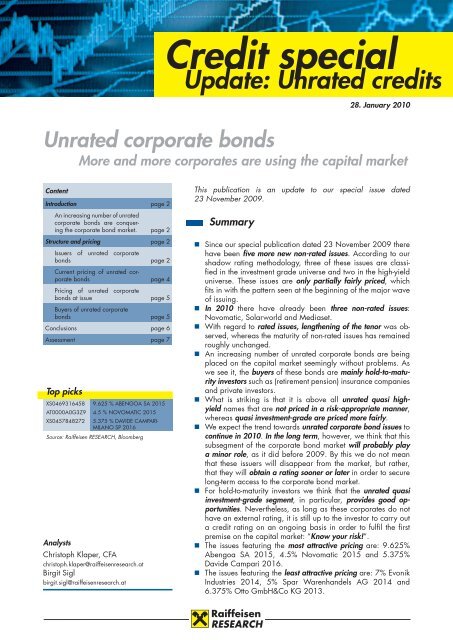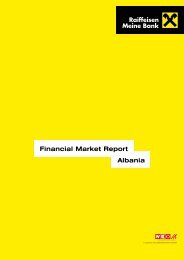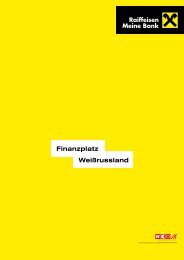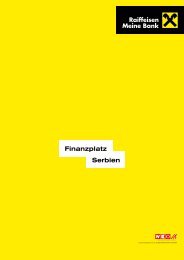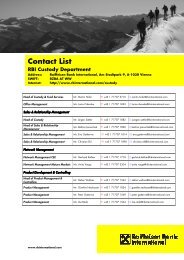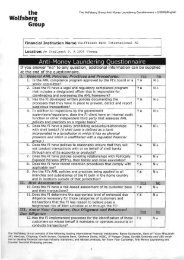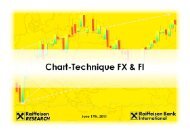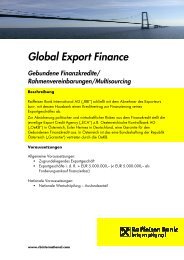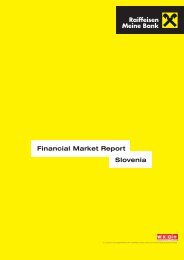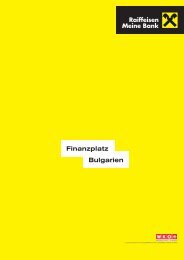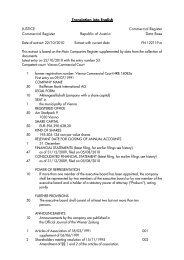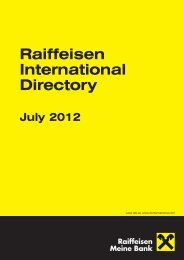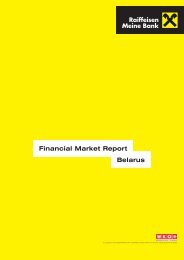Credit special - Raiffeisen Bank International AG
Credit special - Raiffeisen Bank International AG
Credit special - Raiffeisen Bank International AG
You also want an ePaper? Increase the reach of your titles
YUMPU automatically turns print PDFs into web optimized ePapers that Google loves.
Content<br />
Introduction page 2<br />
An increasing number of unrated<br />
corporate bonds are conquering<br />
the corporate bond market. page 2<br />
Structure and pricing page 2<br />
Issuers of unrated corporate<br />
bonds page 2<br />
Current pricing of unrated corporate<br />
bonds page 4<br />
Pricing of unrated corporate<br />
bonds at issue page 5<br />
Buyers of unrated corporate<br />
bonds page 5<br />
Conclusions page 6<br />
Assessment page 7<br />
Analysts<br />
Christoph Klaper, CFA<br />
christoph.klaper@raiffeisenresearch.at<br />
Birgit Sigl<br />
birgit.sigl@raiffeisenresearch.at<br />
<strong>Credit</strong> <strong>special</strong><br />
Update: Unrated credits<br />
28. January 2010<br />
Unrated corporate bonds<br />
More and more corporates are using the capital market<br />
Top picks<br />
XS0469316458 9.625 % ABENGOA SA 2015<br />
AT0000A0G3Z9 4.5 % NOVOMATIC 2015<br />
XS0457848272 5.375 % DAVIDE CAMPARI-<br />
MILANO SP 2016<br />
Source: <strong>Raiffeisen</strong> RESEARCH, Bloomberg<br />
This publication is an update to our <strong>special</strong> issue dated<br />
23 November 2009.<br />
Summary<br />
� Since our <strong>special</strong> publication dated 23 November 2009 there<br />
have been five more new non-rated issues. According to our<br />
shadow rating methodology, three of these issues are classified<br />
in the investment grade universe and two in the high-yield<br />
universe. These issues are only partially fairly priced, which<br />
fits in with the pattern seen at the beginning of the major wave<br />
of issuing.<br />
� In 2010 there have already been three non-rated issues:<br />
Novomatic, Solarworld and Mediaset.<br />
� With regard to rated issues, lengthening of the tenor was observed,<br />
whereas the maturity of non-rated issues has remained<br />
roughly unchanged.<br />
� An increasing number of unrated corporate bonds are being<br />
placed on the capital market seemingly without problems. As<br />
we see it, the buyers of these bonds are mainly hold-to-maturity<br />
investors such as (retirement pension) insurance companies<br />
and private investors.<br />
� What is striking is that it is above all unrated quasi highyield<br />
names that are not priced in a risk-appropriate manner,<br />
whereas quasi investment-grade are priced more fairly.<br />
� We expect the trend towards unrated corporate bond issues to<br />
continue in 2010. In the long term, however, we think that this<br />
subsegment of the corporate bond market will probably play<br />
a minor role, as it did before 2009. By this we do not mean<br />
that these issuers will disappear from the market, but rather,<br />
that they will obtain a rating sooner or later in order to secure<br />
long-term access to the corporate bond market.<br />
� For hold-to-maturity investors we think that the unrated quasi<br />
investment-grade segment, in particular, provides good opportunities.<br />
Nevertheless, as long as these corporates do not<br />
have an external rating, it is still up to the investor to carry out<br />
a credit rating on an ongoing basis in order to fulfil the first<br />
premise on the capital market: “Know your risk!”.<br />
� The issues featuring the most attractive pricing are: 9.625%<br />
Abengoa SA 2015, 4.5% Novomatic 2015 and 5.375%<br />
Davide Campari 2016.<br />
� The issues featuring the least attractive pricing are: 7% Evonik<br />
Industries 2014, 5% Spar Warenhandels <strong>AG</strong> 2014 and<br />
6.375% Otto GmbH&Co KG 2013.
<strong>Credit</strong> <strong>special</strong><br />
2<br />
Introduction<br />
An increasing number of unrated corporate<br />
bonds are conquering the corporate bond<br />
market.<br />
After the strong rally in spreads in the last two months<br />
and the sustained brisk activity on the primary market,<br />
we wish to issue an update on the current situation<br />
in non-rated bonds and explore the question of<br />
whether and in what respect the factors seen in the<br />
past have changed.<br />
Over the past few months the positive sentiment on<br />
the capital market has created a species that was<br />
rarely encountered before the financial market crisis:<br />
corporate bonds without a rating. These bonds<br />
do not have an external credit rating by a rating<br />
agency, which means that no external statement has<br />
been made about their default probability. Nevertheless,<br />
such paper has basically been placed without<br />
any trouble. Is a new attractive investment category<br />
establishing itself?<br />
Since September 2009 alone, more than EUR 10 billion<br />
in unrated corporate bonds have been issued. In<br />
some cases, the issuing companies are not listed on<br />
the stock market either, they have limited experience<br />
of the capital market and are subject to strict and<br />
regular reporting duties to a limited extent only.<br />
The expected growth of this segment is considered to<br />
be due to the fact that many corporates are turning<br />
away from banks as their most essential source of<br />
finance.<br />
Since our <strong>special</strong> publication two months ago, another<br />
five non-rated bonds with a total volume of<br />
more than EUR 2 bn have been issued, underlining<br />
the good conditions for placing such bonds on the<br />
market. If one assumes that retail and other hold-tomaturity<br />
investors only subscribe issues with smaller<br />
denominations, since September 55% of the issues<br />
under review were directed at these investor groups.<br />
The distribution between the investment grade category<br />
and the high-yield category is roughly balanced;<br />
whereby differences can be seen in the pricing<br />
and the risk premia (see below for more details).<br />
Unrated EUR issues vs total issues<br />
350<br />
300<br />
250<br />
200<br />
150<br />
100<br />
50<br />
0<br />
Jan-09 Apr-09 May-09 Jul-09 Sep-09 Nov-09 Jan-10<br />
Cumulative rated issues 2009 (in EUR bn)<br />
Cumulative not rated EUR issues 2009 (in EUR bn, r.h.s.)<br />
Source: <strong>Raiffeisen</strong> RESEARCH, Bloomberg<br />
25%<br />
20%<br />
15%<br />
10%<br />
5%<br />
0%<br />
-5%<br />
-10%<br />
-15%<br />
-20%<br />
Structure and pricing<br />
Issuers of unrated corporate bonds<br />
Of the issuing volume of unrated corporate bonds<br />
totalling around EUR 15 billion (since March 2009),<br />
it is above all cyclical companies that are showing<br />
themselves to be the largest issuers in this segment<br />
(see next chart). By contrast, energy companies and<br />
utilities together with those in the capital goods industry<br />
are substantially underrepresented.<br />
Mostly cyclicals not rated!<br />
Services Cyclical<br />
Media<br />
Consumer Cyclical<br />
Consumer Non-Cyclical<br />
Basic Industry<br />
Technology & Electronics<br />
Real Estate<br />
Energy<br />
Capital Goods<br />
Utility<br />
Share of not rated issuance minus share of rated issuance (%)<br />
Source: <strong>Raiffeisen</strong> RESEARCH, Bloomberg<br />
Furthermore, most issuers of unrated corporate bonds<br />
had only one or no bond outstanding before the issue,<br />
and many are using the corporate bond market<br />
for the first time to refinance themselves. In comparison,<br />
an average issuer on the corporate bond market<br />
in 2009 already had six or seven bonds outstanding.<br />
20<br />
18<br />
16<br />
14<br />
12<br />
10<br />
8<br />
6<br />
4<br />
2<br />
0
Number of outstanding bonds per issuer<br />
40%<br />
35%<br />
30%<br />
25%<br />
20%<br />
15%<br />
10%<br />
5%<br />
0%<br />
< 1 1 - 2 3 - 4 5 - 10 11 - 20 21 - 50 51 -<br />
100<br />
Average number of outstanding bonds per issuer (total 2009)<br />
101 -<br />
500<br />
Average number of outstanding bonds per issuer (only not rated<br />
2009)<br />
Source: <strong>Raiffeisen</strong> RESEARCH, Bloomberg<br />
If we take into account the banks’ restrained lending,<br />
it is not surprising that more and more unrated corporates<br />
issue bonds, as in some cases no alternative<br />
loan finance is available to them. At the same time,<br />
banks benefit from assisting unrated issuers during<br />
their placement, thereby generating the currently preferred<br />
commission income (without putting pressure<br />
on the credit limit). The interests of banks and those<br />
of many companies are thus at present identical and<br />
are pushing the issuing volume of unrated corporate<br />
bonds to historical highs. This suggests that further<br />
issues of unrated issuers can be expected in the<br />
months to come.<br />
Before 2009, a maximum 1% to 2% of all non-financial<br />
corporate bond issuers were not rated. Cast<br />
your mind back to “pre-crisis times”, when companies<br />
found it very difficult to place corporate bonds<br />
at very low risk premiums. In 2009, the percentage<br />
of unrated corporate bonds totalled roughly 5% of<br />
all new issues; particularly in the second half of the<br />
year we have seen a substantial increase in the issuing<br />
momentum.<br />
Proportion of not rated issues*<br />
7.00%<br />
6.00%<br />
5.00%<br />
4.00%<br />
3.00%<br />
2.00%<br />
1.00%<br />
0.00%<br />
<strong>Credit</strong> <strong>special</strong><br />
2006 2007 2008 2009 Jan 2010<br />
* in % of total issues<br />
Source: <strong>Raiffeisen</strong> RESEARCH, Bloomberg<br />
For these companies to remain long-term on the corporate<br />
bond market, however, we think that they will<br />
have to undergo a rating process sooner or later.<br />
The reason for this is obvious: generally speaking,<br />
a company without a rating incurs higher financing<br />
costs than one with a rating.<br />
The long-term independence of corporates from<br />
banks as their source of financing only makes sense<br />
in economic terms if the companies undergo a rating<br />
process and are thus able to finance themselves more<br />
cheaply (in comparison with a non-rated status). By<br />
contrast, if the corporate bond market is only going<br />
to be used as a short-term default source of financing<br />
and if the companies plan to return to their main<br />
bank after the “crisis” or if the main bank holds out<br />
the prospect of bank financing in the future, then the<br />
current high issuing volume of unrated companies fits<br />
into the picture better.<br />
We think that, yes, corporates are seeking greater<br />
independence from their banks; however, this is convincing<br />
only in the case of corporates that have obtained<br />
a rating before the issue or plan to do so. Accordingly,<br />
the segment of rated issues should rise, but<br />
not that of unrated ones. The proof is supplied by the<br />
corporates themselves. Those who use the corporate<br />
bond market as a source of financing frequently, are<br />
in fact rated. Only those who do not use it frequently,<br />
like to dispense with a rating.<br />
3
<strong>Credit</strong> <strong>special</strong><br />
4<br />
Current pricing of unrated corporate bonds<br />
If unrated corporate bonds were to be rated, the<br />
bonds issued since September 2009 would be found<br />
in almost all rating segments. Taking pricing as a<br />
basis, in our view these are bonds covering a rating<br />
spectrum from A+ to BB-.<br />
Pricing spectrum<br />
600<br />
500<br />
400<br />
300<br />
200<br />
100<br />
0<br />
not rated<br />
issues 2009/10<br />
BB+<br />
BBB+<br />
BBB-<br />
BBB<br />
0 5 10 15<br />
A-<br />
A<br />
A+<br />
AA-<br />
We have given the newly issued, unrated corporate<br />
bonds a “shadow rating” or a rating assessment,<br />
i.e. an indication of a possible external rating. This<br />
assessment is based on a Merton model analysis<br />
(= quantitative calculation of a default probability on<br />
the basis of balance sheet and stock market data)<br />
and an analysis of the most important financials and<br />
rating drivers of these companies. We do not claim<br />
that our shadow rating represents an exact calculation<br />
of a possible external rating, but would like to<br />
show by how much the market-implied rating of unrated<br />
corporate bonds may differ from a quantitative/<br />
fundamental assessment of a possible rating.<br />
BB-<br />
Source: <strong>Raiffeisen</strong> RESEARCH, Bloomberg<br />
BB<br />
AA<br />
Shadow rating vs. priced rating<br />
B-14<br />
B13<br />
B+ 12<br />
BB- 11<br />
BB10<br />
BB+ 9<br />
BBB- 8<br />
BBB7<br />
BBB+ 6<br />
A- 5<br />
A 4<br />
A+ 3<br />
AA- 2<br />
0 1 2 3 4 5 6 7 8 9 101112131415161718192021222324<br />
Rating shadow Priced rating<br />
1) ...3.75 % CHRISTIAN DIOR 2014, 2) ...4.625 % HEINEKEN NV<br />
2016, 3) ...4.75 % BEW<strong>AG</strong> - BURGENLAEND ELEK 2014, 4) ...5.375 %<br />
DAVIDE CAMPARI-MILANO SP 2016, 5) ...4.5 % NOVOMATIC 2015,<br />
6) ...4.75 % ADIDAS INTL FINANCE BV 2014, 7) ...5.25 % FRAPORT<br />
<strong>AG</strong> 2019, 8) ...4 % SAFRAN SA 2014, 9) ...5.5 % HAVAS SA 2014,<br />
10) ...4.875 % AP MOLLER-MAERSK A/S 2014, 11) ...5.75 % UCB SA<br />
2014, 12) ...5.75 % UCB SA 2016, 13) ...9.625 % ABENGOA SA 2015,<br />
14) ...4.875 % L<strong>AG</strong>ARDERE SCA 2014, 15) ...6.125 % CA IMMOBILIEN<br />
ANL<strong>AG</strong>EN <strong>AG</strong> 2014, 16) ...8.375 % RALLYE SA 2015, 17) ...7.625 %<br />
RALLYE SA 2016, 18) ...6.75 % AIR FRANCE-KLM 2016, 19) ...5.375 %<br />
SIXT <strong>AG</strong> 2012, 20) ...6.125 % SOLARWORLD 2017, 21) ...5 % SPAR<br />
OESTER. WARENHANDEL 2014, 22) ...6.375 % OTTO GMBH & CO KG<br />
2013, 23) ...7 % EVONIK INDUSTRIES <strong>AG</strong> 2014<br />
Source: <strong>Raiffeisen</strong> RESEARCH, Bloomberg<br />
It is conspicuous that above all quasi high-yield<br />
names are not adequately priced in terms of risk<br />
whereas the pricing of quasi investment-grade securities<br />
are much more closely in line with the shadow<br />
ratings, i.e. are adequately priced in terms of risk.<br />
In other words, unrated quasi high-yield corporate<br />
bonds tend to be expensive. This is illustrated by the<br />
above chart. While the shadow rating (grey) reflects<br />
the fundamental assessment of a possible rating<br />
(and is the basis for assignment to the high-yield or<br />
investment-grade segment), the priced rating (blue)<br />
in some cases shows considerable differences compared<br />
to the shadow rating, to the disadvantage of<br />
buyers of these bonds. The converse picture can be<br />
seen in the case of unrated, but quasi investmentgrade<br />
corporate bonds. In our view, here the market<br />
compensates for the existing default risk well to very<br />
well.<br />
For hold-to-maturity investors we believe that above<br />
all the unrated quasi investment-grade segment still<br />
offers good opportunities. Nevertheless: as long as<br />
these companies do not have any external rating, the<br />
investor’s task is to constantly ascertain a credit rating<br />
in order to fulfill the first principle on the capital<br />
market: “Know your risk!”
Pricing of unrated corporate bonds at issue<br />
In our opinion unrated corporate bonds should<br />
pay higher risk premiums compared to their rated<br />
counterparts. This is also quite clearly the case for<br />
investment-grade issues (see chart below). Unrated<br />
corporate bonds with an average shadow rating of A<br />
showed higher risk premiums at issue than comparable<br />
corporate bonds with an external A rating issued<br />
at around the same time.<br />
This makes sense as an external rating generally has<br />
a certain value for the investor, which is expressed<br />
in the form of lower risk premiums. In other words,<br />
the investor implicitly pays for the rating by providing<br />
the company with cheaper funding than if the corporate<br />
had not been rated. If the company is not rated,<br />
the investor incurs opportunity costs (e.g. independent<br />
calculation of a rating, continuous monitoring of<br />
same), for which he would like to be compensated.<br />
This means that if the investor is able to calculate<br />
and evaluate these opportunity costs, he should be<br />
rewarded in the form of higher risk premiums.<br />
The market seems to apply the reverse logic in the<br />
case of high-yield bonds. Unrated corporate bonds<br />
with an average shadow rating of BB showed lower<br />
risk premiums at issue than comparable corporate<br />
bonds with an external BB rating issued at around<br />
the same time.<br />
New issues since September 2009<br />
Launch spread in bp<br />
500<br />
450<br />
400<br />
350<br />
300<br />
250<br />
200<br />
150<br />
100<br />
50<br />
0<br />
Not rated IG issues with higher<br />
launch spreads than rated IG<br />
issues<br />
4 5 6 7 8 9 10<br />
Maturity in years<br />
HY new issues (not rated) HY new issues (rated BB)<br />
IG new issues (not rated) IG new issues (rated A)<br />
Source: <strong>Raiffeisen</strong> RESEARCH, Bloomberg<br />
?<br />
not rated HY issues with<br />
lower launch spreads than<br />
rated<br />
Additionally, since our publication in November it<br />
has been seen that the maturity of the bonds issued<br />
has lengthened: for rated issues in the high-yield segment<br />
the average maturity has lengthened by two<br />
years, rising from five years to seven years.<br />
Although we suspect that above all retail investors<br />
have bought unrated quasi high-yield corporate<br />
�<br />
bonds in the past, basically these corporate bonds<br />
do not represent a suitable investment precisely for<br />
this investor base.<br />
Interpretation: Whereas the pricing of investmentgrade<br />
new issues is realistic, we believe that some<br />
high-yield risks are not identified (because they cannot<br />
be recognized ad hoc as such). This raises the<br />
question: Who buys these bonds and why are e<strong>special</strong>ly<br />
high-yield bonds with a low credit rating apparently<br />
mispriced?<br />
Many investors evaluate the bonds according to<br />
the actual pricing upon issue, whereby they take<br />
into account other comparable bonds to reach an<br />
assessment of whether a bond belongs more in the<br />
investment grade segment or more in the high-yield<br />
segment. But this approach has the following problem:<br />
for non-rated issues, the launch spread often<br />
points to investment grade level risk, which would<br />
actually be classified more appropriately in the highyield<br />
segment upon a closer fundamental examination.<br />
Some reasons that we see for this “misassessment”<br />
are mainly investors’ rising risk appetite and<br />
an increasing lack of risk differentiation.<br />
Buyers of unrated corporate bonds<br />
<strong>Credit</strong> <strong>special</strong><br />
1) Most of the non-rated bonds which were issued exhibit<br />
a low, “retail-friendly”, denomination structure,<br />
as a result of which we presume that retail and not institutional<br />
investors tend to buy these kinds of bonds.<br />
2) The investor base for high-yield corporate bonds<br />
is much smaller than that for investment-grade bonds.<br />
Above all institutional investors can calculate shadow<br />
ratings and identify risk-adequate pricings themselves.<br />
We therefore suspect that this investor base<br />
has participated principally in investment-grade issues<br />
that are adequately priced in terms of risk within<br />
the framework of unrated issues.<br />
3) Above all institutional investors have to comply<br />
with certain rules of the game for investment. For instance,<br />
its is very often stipulated that they may only<br />
invest in bonds with an investment-grade rating or<br />
that there must be at least one rating by an external<br />
rating agency in order to be permitted to invest<br />
at all. Assuming that a company wishes to place its<br />
corporate bonds in a free float in the long term too,<br />
increase the probability of a successful placement<br />
and reduce the refinancing risk, there is an automatic<br />
incentive to go through an external rating process.<br />
Without these prerequisites there is no incentive to<br />
subject themselves to a possibly lengthy and expensive<br />
rating process.<br />
5
<strong>Credit</strong> <strong>special</strong><br />
6<br />
4) The spread performance of unrated corporate<br />
bonds was much poorer shortly after issue (one<br />
week) than corporate bonds with similar credit standing,<br />
but which had been rated (see chart below). This<br />
leads to the conclusion that these bonds were not<br />
heavily traded, but find their way into hold-to- maturity<br />
portfolios more rapidly. Classical hold-to-maturity<br />
investors are (retirement pension) insurance companies<br />
and private investors.<br />
Spread tightening in %*<br />
12%<br />
8%<br />
4%<br />
0%<br />
HY new<br />
issues (not<br />
rated)<br />
IG new<br />
issues (not<br />
rated)<br />
* one week after issues<br />
Source: <strong>Raiffeisen</strong> RESEARCH, Bloomberg<br />
HY new<br />
issues (rated<br />
BB)<br />
IG new<br />
issues (rated<br />
A)<br />
5) The unrated bond issues are generally rare names<br />
on the corporate bond market (often with one bond<br />
outstanding or none at all), which is why these bonds<br />
Unrated corporate bonds<br />
offer the possibility of wider diversification for institutional<br />
investors. For us this characteristic represents<br />
the main reason for buying unrated corporate bonds<br />
by fund companies. Nevertheless, we assume that<br />
these have mainly participated in the “fairly” priced<br />
quasi investment-grade corporate bonds.<br />
Conclusions<br />
ISIN Name Maturity Volume<br />
in EUR bn<br />
The strong demand for new issues, the search for a<br />
high yield, the possibility of additional opportunities<br />
for diversifying and the fact that many rated companies<br />
are already fully funded has meant than even unrated<br />
companies in dubious sectors can be placed.<br />
This trend will further be observable in the upcoming<br />
months. However, this can be done without the need<br />
for going through an occasionally lengthy and expensive<br />
rating process.<br />
If the financial markets continue to return to normal,<br />
this means that the number of unrated new issues will<br />
decrease significantly. By this we do not mean that<br />
these issuers will disappear from the market, but that<br />
sooner or later they will obtain a rating in order to secure<br />
long-term access to the corporate bond market.<br />
The next issue by a currently unrated issuer may thus<br />
already be rated. As a result the segment of unrated<br />
corporate bonds will slowly disappear. However, this<br />
actually contributes to the growth of the overall corporate<br />
bond universe.<br />
Shadow<br />
rating<br />
Priced<br />
rating<br />
XS0421464719 7.125 % HEINEKEN NV 2014 07.04.2014 1000 A BBB 3.36 109<br />
AT0000A0DJX7 4.75 % BEW<strong>AG</strong> - BURGENLAEND ELEK 2014 03.07.2014 200 A- BBB 3.36 100<br />
XS0439260398 4.75 % ADIDAS INTL FINANCE BV 2014 14.07.2014 500 A- BBB+ 3.47 107<br />
XS0447977801 5.25 % FRAPORT <strong>AG</strong> 2019 10.09.2019 800 A- BBB+ 4.71 136<br />
AT0000A0EN38 5 % SPAR OESTER. WARENHANDEL 2014 18.09.2014 200 BB BBB 3.66 128<br />
FR0010805309 3.75 % CHRISTIAN DIOR 2014 23.09.2014 350 A BBB+ 3.35 89<br />
FR0010806745 8.375 % RALLYE SA 2015 20.01.2015 500 BB BB 6.33 395<br />
FR0010808071 4.875 % L<strong>AG</strong>ARDERE SCA 2014 06.10.2014 1000 BB+ BB+ 3.88 253<br />
AT0000A0EXE6 6.125 % CA IMMOBILIEN ANL<strong>AG</strong>EN <strong>AG</strong> 2014 16.10.2014 150 BB+ BB+ 5.19 275<br />
XS0456567055 4.625 % HEINEKEN NV 2016 10.10.2016 400 A BBB+ 3.88 95<br />
XS0456708212 7 % EVONIK INDUSTRIES <strong>AG</strong> 2014 14.10.2014 750 B+ BB+ 4.92 251<br />
XS0457848272 5.375 % DAVIDE CAMPARI-MILANO SP 2016 14.10.2016 350 A- BBB- 4.70 179<br />
FR0010814459 6.75 % AIR FRANCE-KLM 2016 27.10.2016 700 BB BB+ 5.72 282<br />
FR0010815472 7.625 % RALLYE SA 2016 04.11.2016 500 BB BB 6.60 372<br />
BE6000431112 5.75 % UCB SA 2014 27.11.2014 750 BBB- BBB- 4.34 188<br />
XS0462887349 4.875 % AP MOLLER-MAERSK A/S 2014 30.10.2014 750 BBB BBB- 4.16 165<br />
FR0010820217 5.5 % HAVAS SA 2014 04.11.2014 350 BBB BB+ 4.86 237<br />
DE000A1A6UM3 5.375 % SIXT <strong>AG</strong> 2012 06.11.2012 300 BB BB+ 4.21 236<br />
XS0467329016 6.375 % OTTO GMBH & CO KG 2013 20.11.2013 500 BB- BB+ 5.06 292<br />
XS0469316458 9.625 % ABENGOA SA 2015 25/02/2015 300 BB+ BB- 7.73 529<br />
FR0010827048 4 % SAFRAN SA 2014 26/11/2014 750 BBB+ BBB+ 3.61 107<br />
BE6000480606 5.75 % UCB SA 2016 10/12/2016 500 BBB- BBB- 4.97 204<br />
XS0478864225 6.125 % SOLARWORLD 2017 21/01/2017 400 BB BB+ 6.46 338<br />
AT0000A0G3Z9 4.5 % NOVOMATIC 2015 22/01/2015 200 A- BBB- 4.54 200<br />
Indicative values, ASW . . . Asset Swap Spread<br />
Source: <strong>Raiffeisen</strong> RESEARCH, Bloomberg<br />
Yield<br />
in %<br />
ASW<br />
in bp
Assessment<br />
Attractive pricing<br />
ISIN Name Shadow rating Priced rating Curr. ASW<br />
in bp<br />
<strong>Credit</strong> <strong>special</strong><br />
Fair ASW<br />
in bp<br />
XS0421464719 7.125 % HEINEKEN NV 2014 A BBB 110 50<br />
FR0010805309 3.75 % CHRISTIAN DIOR 2014 A BBB+ 90 52<br />
XS0456567055 4.625 % HEINEKEN NV 2016 A BBB+ 96 61<br />
AT0000A0DJX7 4.75 % BEW<strong>AG</strong> - BURGENLAEND ELEK 2014 A- BBB 100 64<br />
XS0439260398 4.75 % ADIDAS INTL FINANCE BV 2014 A- BBB+ 107 64<br />
XS0447977801 5.25 % FRAPORT <strong>AG</strong> 2019 A- BBB+ 136 88<br />
XS0457848272 5.375 % DAVIDE CAMPARI-MILANO SP 2016 A- BBB- 179 77<br />
AT0000A0G3Z9 4.5 % NOVOMATIC 2015 A- BBB- 200 68<br />
XS0469316458 9.625 % ABENGOA SA 2015 BB+ BB- 529 258<br />
XS0462887349 4.875 % AP MOLLER-MAERSK A/S 2014 BBB BBB- 165 129<br />
FR0010820217 5.5 % HAVAS SA 2014 BBB BB+ 237 129<br />
Source: <strong>Raiffeisen</strong> RESEARCH, Bloomberg<br />
Fair pricing<br />
ISIN Name Shadow rating Priced rating Curr. ASW<br />
in bp<br />
Fair ASW<br />
in bp<br />
FR0010806745 8.375 % RALLYE SA 2015 BB BB 395 346<br />
FR0010815472 7.625 % RALLYE SA 2016 BB BB 372 371<br />
FR0010808071 4.875 % L<strong>AG</strong>ARDERE SCA 2014 BB+ BB+ 253 254<br />
AT0000A0EXE6 6.125 % CA IMMOBILIEN ANL<strong>AG</strong>EN <strong>AG</strong> 2014 BB+ BB+ 275 254<br />
BE6000431112 5.75 % UCB SA 2014 BBB- BBB- 188 147<br />
BE6000480606 5.75 % UCB SA 2016 BBB- BBB- 204 167<br />
FR0010827048 4 % SAFRAN SA 2014 BBB+ BBB+ 108 80<br />
Source: <strong>Raiffeisen</strong> RESEARCH, Bloomberg<br />
Unattractive pricing<br />
ISIN Name Shadow rating Priced rating Curr. ASW<br />
in bp<br />
Fair ASW<br />
in bp<br />
XS0456708212 7 % EVONIK INDUSTRIES <strong>AG</strong> 2014 B+ BB+ 252 507<br />
AT0000A0EN38 5 % SPAR OESTER. WARENHANDEL 2014 BB BBB 129 341<br />
FR0010814459 6.75 % AIR FRANCE-KLM 2016 BB BB+ 282 371<br />
DE000A1A6UM3 5.375 % SIXT <strong>AG</strong> 2012 BB BB+ 235 299<br />
XS0478864225 6.125 % SOLARWORLD 2017 BB BB+ 340 374<br />
XS0467329016 6.375 % OTTO GMBH & CO KG 2013 BB- BB+ 294 476<br />
Source: <strong>Raiffeisen</strong> RESEARCH, Bloomberg<br />
7
8<br />
<strong>Credit</strong> <strong>special</strong><br />
Acknowledgement<br />
This report was completed on 28 January 2010.<br />
Editor<br />
<strong>Raiffeisen</strong> RESEARCH GmbH<br />
A-1030 Vienna, Am Stadtpark 9<br />
Telefon: +43 1 717 07-1521<br />
Economics and Financial Markets Research<br />
Head:<br />
Peter Brezinschek (1517)<br />
<strong>Credit</strong> <strong>special</strong><br />
Economics, Fixed Income, FX:<br />
Valentin Hofstätter (Head, 1685), Jörg Angele (1687), Walter Demel (1526), Wolfgang Ernst (1500), Ingo<br />
Jungwirth (2139), Marcin Kopaczynski (1423), Julia Neudorfer (5842), Andreas Schwabe (1389), Gintaras<br />
Shlizhyus (1343), Gottfried Steindl (1523), Martin Stelzeneder (1614)<br />
<strong>Credit</strong>/Corporate Bonds:<br />
Christoph Klaper (Head, 1652), Martin Kutny (2013), Doris Oswald (1631), Manuel Schreiber (3533), Gleb<br />
Shpilevoy (1461), Birgit Sigl (5892), Alexander Sklemin (1212), Beatrix Thaler (5924)<br />
Stocks:<br />
Helge Rechberger (Head, 1533), Aaron Alber (1513), Christian Hinterwallner (1633), Jörn Lange (2169),<br />
Hannes Loacker (1885), Richard Malzer (5935), Johannes Mattner (1463), Christine Nowak (1625), Leopold<br />
Salcher (2176), Andreas Schiller (1358), Connie Schümann (2178), Magdalena Wasowicz (2169)<br />
Quant Research/Emerging Markets:<br />
Veronika Lammer (Head, 3741), Lydia Kranner (1609), Nina Kukic (1635), Christian Link (1355), Andreas<br />
Reschreiter (1683), Josef Wolfesberger (1529)<br />
Technical analysis:<br />
Klemens Hrovath (1421), Robert Schittler (1537)<br />
This document does not constitute an offer or invitation to subscribe for or purchase any securities and neither this document nor anything contained herein shall form the basis of any<br />
contract or commitment whatsoever. This document is being furnished to you solely for your information and may not be reproduced or redistributed to any other person. Any investment<br />
decision with respect to any securities of the respective company must be made on the basis of an offering circular or prospectus approved by such company and not on the basis of<br />
this document. RZB may have effected an own account transaction in any investment mentioned herein or related investments and or may have a position or holding in such investments<br />
as a result. RZB may have been, or might be, acting as a manager or co-manager of a public offering of any securities mentioned in this report or in any related security. Information<br />
contained herein is based on sources, including annual reports and other material which might have been made available by the entity which is the subject of this document. RZB believes<br />
all the information to be reliable, but no representations are made as to their accuracy and completeness. Unless otherwise stated, all views (including statements and forecasts) are solely<br />
those of RZB and are subject to change without notice. Investors in emerging markets need to be aware that settlement and custodial risk may be higher than in markets where there is a<br />
long established infrastructure and that stock liquidity may be impacted by the numbers of market makers which may therefore impact upon the reliability of any investments made as a<br />
result of acting upon information contained in this document. Special regulations for the Republic of Austria: This document does not constitute either a public offer in the meaning of the<br />
Kapitalmarktgesetz („KMG“) nor a prospectus in the meaning of the KMG or of the Börsegesetz. Furthermore this document does not intend to recommend the purchase or the sale of<br />
securities or investments in the meaning of the Wertpapieraufsichtsgesetz. This document shall not replace the necessary advice concerning the purchase or the sale of securities or investments.<br />
For any advice concerning the purchase or the sale of securities or investments kindly contact your RAIFFEISENBANK. Special regulations for the United Kingdom of Great Britain,<br />
Northern Ireland (UK) and Jersey (Channel Islands): <strong>Raiffeisen</strong> Zentralbank. This publication has been either approved or issued by <strong>Raiffeisen</strong> Zentralbank Österreich <strong>AG</strong> (RZB) in order<br />
to promote its investment business. RZB London Branch is authorised by the Austrian Financial Market Authority (FMA) and subject to limited regulation by the Financial Services Authority<br />
(FSA). Details on the extent of the London branch‘s regulation by the Financial Services Authority are available on request. This publication is not intended for investors who are Retail<br />
Customers within the meaning of the FSA rules and should therefore not be distributed to them. Neither the information nor the opinions expressed herein constitute or are to be construed<br />
as an offer or solicitation of an offer to buy (or sell) investments. RZB may have effected an Own Account Transaction within the meaning of FSA rules in any investment mentioned herein<br />
or related investments and or may have a position or holding in such investments as a result. RZB may have been, or might be, acting as a manager or co-manager of a public offering of<br />
any securities mentioned in this report or in any related security. The RZB Jersey marketing representative office is not regulated by the Jersey Financial Services Commission as it does not<br />
perform any financial services activity in Jersey as defined by the Financial Services (Jersey) Law 1998 (FSJL).Special regulations for the United States of America (USA) and Canada: This<br />
document or any copy hereof may not be taken or transmitted or distributed, in the USA or Canada or their respective territories or possessions nor may it be distributed to any USA-person<br />
or person resident in Canada by any means other than via a US Broker Dealer. Any failure to comply with these restrictions may constitute a violation of USA or Canadian securities laws.<br />
Detailed disclaimer and disclosure as per Sect. 48f of the Stock Exchange Act: http://www.raiffeisenresearch.at -> “Disclaimer”


